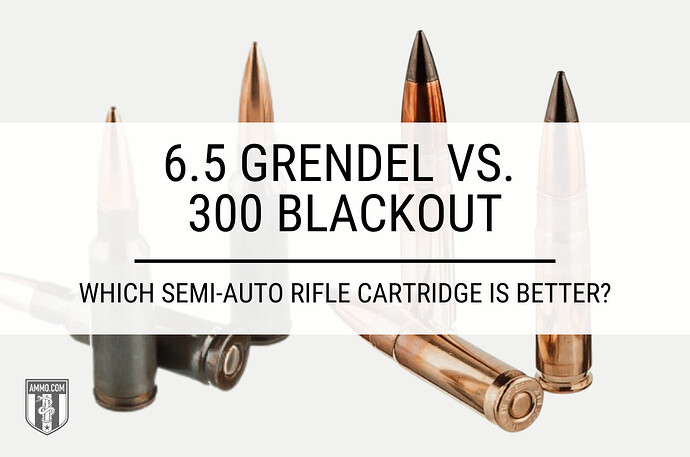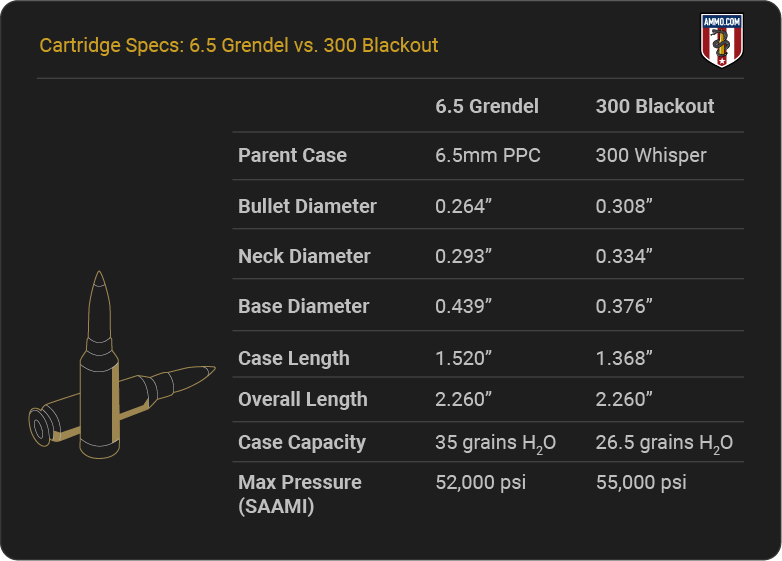The 6.5 Grendel and 300 Blackout were designed to outperform the 5.56 NATO in the AR-15 platform. One uses a 6.5mm (.264 caliber) projectile; the other, a .30 caliber bullet.
As you continue reading, you’ll discover how the differences in cartridge size and projectile choice affect the performance of each round in the real world.
We’ll judge each cartridge on recoil, trajectory, accuracy, cost, and a few other critical factors.
6.5 Grendel vs. 300 Blackout Comparison
While both cartridges were designed for a similar purpose, they approached it differently and at various times in history.
The 300 BLK is a slightly newer cartridge (approved by SAAMI in 2011). The 6.5 Grendel was released in 2003, so the 300 AAC BLK has the advantage of correcting the mistakes that Bill Alexander, creator of the 6.5 Grendel, made.
Is the 300 Blackout an improvement on the 6.5 Grendel and 5.56 NATO?
Let’s find out by starting with the cartridges’ specs.
Cartridge Specs
At first glance, there are only minor differences in the cartridges’ specs. You’ll notice that the 300 BLK has a larger bullet diameter (0.308 inches vs. 0.264 inches) than the 6.5 Grendel. The 300 AAC BLK is also capable of firing heavier bullets. The bullet weight range for the Blackout is typically between 110 to 220 grain (subsonic rounds), whereas the Grendel has a bullet weight range of 80 to 144 grain.
However, the 6.5 Grendel has a larger base diameter (0.439 inches vs. 0.376 inches) than the 300 AAC Blackout. The larger case lowers the magazine capacity and limits the number of rounds a soldier can carry onto the battlefield – one reason why it didn’t take off among national militaries.
The two rounds’ overall lengths are identical because they were designed for the AR platform’s STANAG magazine. The case length of the 6.5 Grendel is 1.52 inches (compared to 1.368 inches for 300 BLK), which increases its case capacity over the 300 BLK (35 grains H2O for the Grendel and 26.5 grains H2O for the Blackout).
The maximum pressure of each cartridge is similar: 52,000 psi for the 6.5 Grendel and 55,000 psi for the 300 Blackout. Let’s see how these pressures and cartridge specs affect the recoil of each AR-15 cartridge.
Recoil: 300 BLK vs. 6.5 Grendel
Recoil is an important consideration when purchasing a new rifle, as a round with heavy recoil will be more challenging to control and will slow your follow-up shot rate. Free recoil energy (ft-lbs) is determined by muzzle velocity (fps), propellant charge, bullet weight, and rifle weight. Felt recoil varies from shooter to shooter and cannot be scientifically measured.
The 6.5 Grendel has about 6 ft-lbs of free recoil energy, but it will vary from load to load. The 300 Blackout has about 4 ft-lbs of free recoil energy. While some shooters might notice a slight difference in recoil, these cartridges are quite similar.
The 300 BLK has a slight edge, as it typically has less recoil, especially when comparing lightweight projectiles.
The 300 Blackout wins this first section – but can it hold on to its lead?
Trajectory
Trajectory quantifies a bullet’s flight path to its target, measured in inches of bullet drop. A flatter trajectory is preferred because it requires the shooter to make fewer adjustments in pursuit of accuracy.
This is where the real differences begin to appear. The 300 BLK was designed for close-quarters combat (CQB), so a flat, long-range trajectory wasn’t mandatory for this cartridge. When sighted in at 100 yards, a 125 grain bullet with a muzzle velocity of 2,250 fps will have -7 inches of bullet drop at 200 yards, and -54.8 inches of bullet drop at 400 yards.
While the 6.5 Grendel can’t compete with the 6.5 Creedmoor regarding a flat trajectory, it’s much better than the 300 BLK. When zeroed in at 100 yards, a 123 grain bullet with a muzzle velocity of 2,580 fps will have -4.5 inches of bullet drop at 200 yards, and -35.3 inches of bullet drop at 400 yards.
The 6.5 Grendel ties it back up by having a much flatter trajectory.
Accuracy: 300 Blackout vs. 6.5 Grendel
Accuracy is tricky to analyze as some factors cannot be calculated empirically. Rifle design, barrel life, ammo consistency, shooter skill, and environmental conditions contribute to accuracy.
Recoil also affects accuracy, especially when firing over longer ranges. Many shooters report being more accurate with a rifle that has less recoil. Again, this is because the shooter can focus more on the fundamentals of shooting (breath control, trigger squeeze, not disturbing sight alignment) rather than worrying about how badly the shot is going to hurt.
However, recoil isn’t different enough to severely impact accuracy in this comparison. Most shooters would struggle to tell the difference. Therefore, we should defer to the cartridge with a flatter trajectory.
The 6.5 Grendel will be more accurate, especially at longer ranges (200+ yards).
Continue reading 6.5 Grendel vs. 300 Blackout: Which Semi-Auto Rifle Cartridge Is Better? on Ammo.com

